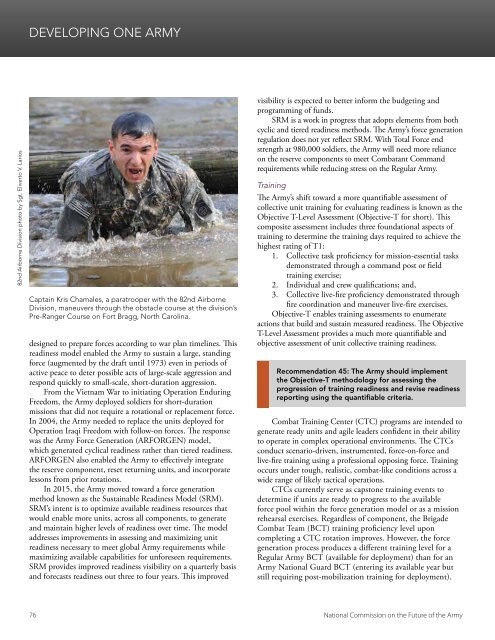THE FUTURE OF THE ARMY
Futurearmy
Futurearmy
You also want an ePaper? Increase the reach of your titles
YUMPU automatically turns print PDFs into web optimized ePapers that Google loves.
DEVELOPING ONE <strong>ARMY</strong><br />
82nd Airborne Division photo by Sgt. Eliverto V. Larios<br />
Captain Kris Chamales, a paratrooper with the 82nd Airborne<br />
Division, maneuvers through the obstacle course at the division’s<br />
Pre-Ranger Course on Fort Bragg, North Carolina.<br />
designed to prepare forces according to war plan timelines. This<br />
readiness model enabled the Army to sustain a large, standing<br />
force (augmented by the draft until 1973) even in periods of<br />
active peace to deter possible acts of large-scale aggression and<br />
respond quickly to small-scale, short-duration aggression.<br />
From the Vietnam War to initiating Operation Enduring<br />
Freedom, the Army deployed soldiers for short-duration<br />
missions that did not require a rotational or replacement force.<br />
In 2004, the Army needed to replace the units deployed for<br />
Operation Iraqi Freedom with follow-on forces. The response<br />
was the Army Force Generation (ARFORGEN) model,<br />
which generated cyclical readiness rather than tiered readiness.<br />
ARFORGEN also enabled the Army to effectively integrate<br />
the reserve component, reset returning units, and incorporate<br />
lessons from prior rotations.<br />
In 2015, the Army moved toward a force generation<br />
method known as the Sustainable Readiness Model (SRM).<br />
SRM’s intent is to optimize available readiness resources that<br />
would enable more units, across all components, to generate<br />
and maintain higher levels of readiness over time. The model<br />
addresses improvements in assessing and maximizing unit<br />
readiness necessary to meet global Army requirements while<br />
maximizing available capabilities for unforeseen requirements.<br />
SRM provides improved readiness visibility on a quarterly basis<br />
and forecasts readiness out three to four years. This improved<br />
visibility is expected to better inform the budgeting and<br />
programming of funds.<br />
SRM is a work in progress that adopts elements from both<br />
cyclic and tiered readiness methods. The Army’s force generation<br />
regulation does not yet reflect SRM. With Total Force end<br />
strength at 980,000 soldiers, the Army will need more reliance<br />
on the reserve components to meet Combatant Command<br />
requirements while reducing stress on the Regular Army.<br />
Training<br />
The Army’s shift toward a more quantifiable assessment of<br />
collective unit training for evaluating readiness is known as the<br />
Objective T-Level Assessment (Objective-T for short). This<br />
composite assessment includes three foundational aspects of<br />
training to determine the training days required to achieve the<br />
highest rating of T1:<br />
1. Collective task proficiency for mission-essential tasks<br />
demonstrated through a command post or field<br />
training exercise;<br />
2. Individual and crew qualifications; and,<br />
3. Collective live-fire proficiency demonstrated through<br />
fire coordination and maneuver live-fire exercises.<br />
Objective-T enables training assessments to enumerate<br />
actions that build and sustain measured readiness. The Objective<br />
T-Level Assessment provides a much more quantifiable and<br />
objective assessment of unit collective training readiness.<br />
Recommendation 45: The Army should implement<br />
the Objective-T methodology for assessing the<br />
progression of training readiness and revise readiness<br />
reporting using the quantifiable criteria.<br />
Combat Training Center (CTC) programs are intended to<br />
generate ready units and agile leaders confident in their ability<br />
to operate in complex operational environments. The CTCs<br />
conduct scenario-driven, instrumented, force-on-force and<br />
live-fire training using a professional opposing force. Training<br />
occurs under tough, realistic, combat-like conditions across a<br />
wide range of likely tactical operations.<br />
CTCs currently serve as capstone training events to<br />
determine if units are ready to progress to the available<br />
force pool within the force generation model or as a mission<br />
rehearsal exercises. Regardless of component, the Brigade<br />
Combat Team (BCT) training proficiency level upon<br />
completing a CTC rotation improves. However, the force<br />
generation process produces a different training level for a<br />
Regular Army BCT (available for deployment) than for an<br />
Army National Guard BCT (entering its available year but<br />
still requiring post-mobilization training for deployment).<br />
76 National Commission on the Future of the Army


